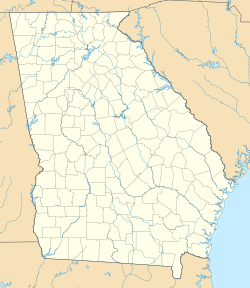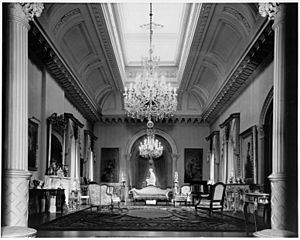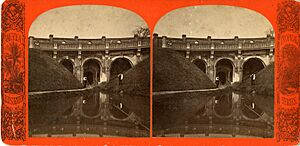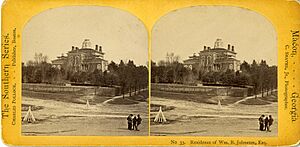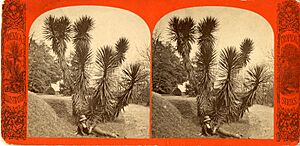Johnston–Felton–Hay House facts for kids
|
Johnston-Hay House
|
|
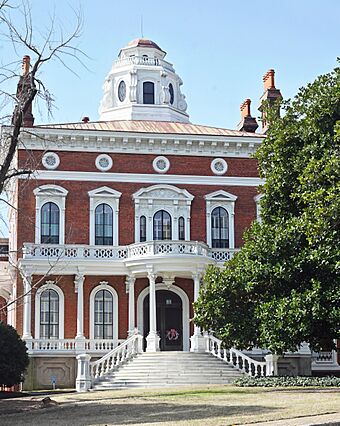
The Johnston–Felton–Hay House in Macon was declared a National Historic Landmark in 1974.
|
|
| Location | 934 Georgia Ave., Macon, Georgia |
|---|---|
| Built | 1855 |
| Architect | T. Thomas and Son |
| Architectural style | Italian Renaissance Revival |
| NRHP reference No. | 71000259 |
Quick facts for kids Significant dates |
|
| Added to NRHP | May 27, 1971 |
| Designated NHL | November 7, 1973 |
The Johnston–Felton–Hay House, often called Hay House, is a famous old home in Macon, Georgia. It was built between 1855 and 1859 by William Butler Johnston and his wife, Anne Tracy Johnston. The house is designed in the Italian Renaissance Revival style. People sometimes call it the "Palace of the South" because it's so grand.
This huge house sits on Coleman Hill in downtown Macon. It's close to the Mercer University law school. In 1973, the Hay House was named a National Historic Landmark. This means it's a very important building because of its special design.
The Hay House is about 1,672 square meters (18,000 square feet) and has 24 rooms. It was designed by architects T. Thomas and Son from New York. Italian craftspeople and local builders helped construct it. The house has four levels and a tall, three-story tower called a cupola on top.
When it was built, the Hay House had amazing technology for its time. It had hot and cold running water and central heating. There was a speaker system connecting 15 rooms. It even had a French lift, which was like an early elevator. The house also had its own kitchen inside and a clever ventilation system.
Contents
History of the Hay House
Two main families lived in the Hay House over the years. The first family, the Johnstons, lived there for many generations. Most of the furniture you see in the house today is from when the Hay family lived there (1926–1962). Some older pieces, like the dining room set, belonged to the Johnston family (1860–1896). One special item is an 1857 marble statue called "Ruth Gleaning" by Randolph Rogers.
The Johnston family and their daughters enjoyed living in the comfortable home until the late 1800s. After Mrs. Johnston passed away in 1896, her daughter Mary Ellen Felton and her husband moved in. The Feltons updated the house with new plumbing and electricity. They lived there until they died in 1926.
The Johnston Family
William Butler Johnston became very rich from banking, railroads, and public services. He did not get his wealth from cotton farming. In 1851, he married Anne Clark Tracy, who was 20 years younger than him. They went on a long honeymoon in Europe from 1852 to 1855.
During their trip, the Johnstons visited many museums and historic places. They also went to art studios. They bought beautiful porcelains, sculptures, and paintings as souvenirs. They were inspired by the Italian buildings they saw. When they returned to America, they built their grand Italian Renaissance Revival mansion in Macon. Only two of their six children, Caroline and Mary Ellen, lived to be adults. They were born in 1862 and 1864 and grew up in the Hay House.
The Felton Family
After Mrs. Johnston died in 1896, her daughter Mary Ellen and her husband, Judge William H. Felton, moved into the house. They updated parts of the house. They also improved the plumbing and added electricity. Their only child, William Hamilton Felton Jr., was born in 1889.
In 1915, William Jr. married Luisa Macgill Gibson. The new couple soon moved in with the Feltons. William Jr. and Luisa had two sons, William Hamilton Felton III and George Gibson Felton. All of them lived in the house until 1926.
The Hay Family
After William Sr. and Mary Ellen Felton passed away, the house was sold to Parks Lee Hay and his wife, Maude. The Hays redecorated the entire home. They updated it to match the popular styles of the 1900s. The house became a well-known landmark in central Georgia. Mr. Hay died in 1957, and Mrs. Hay died in 1962.
The Hay House Today
After Mrs. Hay's death, her family created the P.L. Hay Foundation. This foundation ran the house as a private museum. Because of its important design, the Hay House was named a National Historic Landmark in 1974. In 1977, the house was given to The Georgia Trust for Historic Preservation. This group helps make sure the house is kept safe for a long time.
In 2000, the White House Millennium Council chose Hay House as an Official Project of Save America's Treasures. Today, Hay House is one of Macon's most popular places to visit. About 20,000 people visit it every year. The house is also a popular place to rent for special events.
Keeping Hay House Beautiful
In 2015, The Georgia Trust for Historic Preservation started a big fundraising effort. They successfully raised $7.6 million to restore and maintain the Hay House. Of that money, $3.5 million was set aside to help pay for ongoing care. Experts have said that $17.5 million is needed for a complete restoration of the house. This would also create a fund to pay for all future care and management.
The Georgia Trust received many donations and grants. These included money from the Institute of Museum and Library Services and the National Endowment of the Arts. They also got an Architectural Conservation grant from the Getty Foundation.
Restoration Work
Today, Hay House is open for visitors, with tours held daily. Some of the plants in the garden are from the 1800s. Renovations are always happening to keep Hay House in great shape. Future plans include redesigning the gift shop and repairing the outside walls.
Half of the money raised in the fundraising effort was used to restore the outside of the house. This included the cupola and most of the public rooms. Other restoration work includes fixing the porch and stairs, stone work, and windows. They are also cleaning the stained glass and adding UV protection to windows. The ground floor, attic, and cupola are also being restored. They plan to light up the huge 8,000-gallon water tank inside to show off the house's old technology. They are also working to preserve the paintings and porcelain collections. The outside grounds are being repaired too. Experts are researching the original furniture and decorations in the downstairs rooms. This will help them make sure the walls, paint, and furniture look just like they did when the Hay family lived there.
Gallery
See also
- Georgia Trust for Historic Preservation
- Rhodes Hall
- List of National Historic Landmarks in Georgia (U.S. state)
- National Register of Historic Places listings in Bibb County, Georgia


